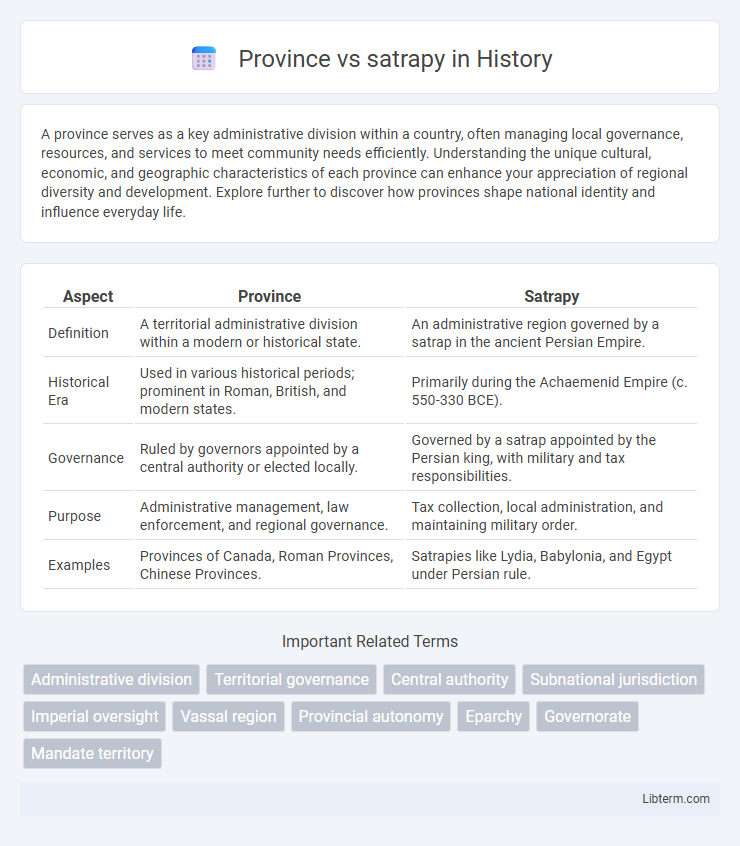A province serves as a key administrative division within a country, often managing local governance, resources, and services to meet community needs efficiently. Understanding the unique cultural, economic, and geographic characteristics of each province can enhance your appreciation of regional diversity and development. Explore further to discover how provinces shape national identity and influence everyday life.
Table of Comparison
| Aspect | Province | Satrapy |
|---|---|---|
| Definition | A territorial administrative division within a modern or historical state. | An administrative region governed by a satrap in the ancient Persian Empire. |
| Historical Era | Used in various historical periods; prominent in Roman, British, and modern states. | Primarily during the Achaemenid Empire (c. 550-330 BCE). |
| Governance | Ruled by governors appointed by a central authority or elected locally. | Governed by a satrap appointed by the Persian king, with military and tax responsibilities. |
| Purpose | Administrative management, law enforcement, and regional governance. | Tax collection, local administration, and maintaining military order. |
| Examples | Provinces of Canada, Roman Provinces, Chinese Provinces. | Satrapies like Lydia, Babylonia, and Egypt under Persian rule. |
Definition of Province and Satrapy
A province is an administrative division within a modern nation-state, governed by local officials who enforce state laws and policies. A satrapy refers to a territorial unit in the ancient Persian Empire, ruled by a satrap appointed by the emperor to oversee military, tax collection, and local administration. Provinces emphasize civil governance under contemporary legal frameworks, while satrapies combined military authority and tax responsibilities under imperial control.
Historical Origins of Provinces and Satrapies
Satrapies originated in the Persian Empire around 550 BCE, established by Cyrus the Great to efficiently govern vast territories through appointed governors known as satraps. Provinces, as administrative divisions, trace back to Roman times, evolving from conquests and territorial integration to facilitate localized governance and tax collection. The development of satrapies reflects early imperial centralization, while provinces demonstrate administrative adaptation across diverse civilizations.
Administrative Structure: Province vs Satrapy
A province is a territorial unit governed by a centralized administrative system, often headed by appointed officials who implement the policies of the central government. A satrapy, historically used in the Achaemenid Empire, functioned as a semi-autonomous region ruled by a satrap, who exercised military, fiscal, and administrative control under the emperor's oversight. While provinces typically emphasize uniform governance and integration within a nation-state, satrapies allowed for greater local autonomy and cultural diversity within an imperial framework.
Governance and Leadership Roles
A province is a territorial unit governed directly by officials appointed by a central government, often featuring standardized administration and consistent legal frameworks. A satrapy, historically linked to the Achaemenid Empire, operates under a satrap, a local ruler granted autonomy to manage regional affairs, collect taxes, and maintain military forces while owing allegiance to the emperor. Governance in provinces tends to emphasize centralized control, whereas satrapies balance local authority with imperial oversight.
Geographic Distribution and Examples
A province typically refers to an administrative division within a modern nation-state, like Ontario in Canada or Guangdong in China, encompassing defined geographic areas for civil governance. A satrapy was an administrative region in the ancient Persian Empire, governed by a satrap, with notable examples including Lydia and Babylonia, representing vast territories often spanning multiple ethnic groups. Provinces are common in contemporary governance systems, while satrapies signify historical imperial control over diverse geographic distributions.
Powers and Functions of Provincial vs Satrapal Rule
Provinces under modern administrative systems typically exercise localized governance, including legislative powers, public service administration, and tax collection, often operating under the framework of a centralized national government. Satrapies, as established in the ancient Persian Empire, were governed by satraps who held military, fiscal, and judicial authority, acting as the king's representatives with broad autonomy to enforce imperial policy and maintain regional security. Unlike modern provinces, satraps combined executive and military powers, enabling them to both govern and defend their territories with considerable independent authority.
Cultural and Social Impact
Provinces typically fostered a more uniform cultural integration through centralized administration and standardized legal systems, promoting social cohesion within the governed territory. Satrapies, as semi-autonomous regions under the Achaemenid Empire, allowed for considerable local customs and traditions to persist, supporting diverse cultural expressions and localized governance structures. This autonomy in satrapies often enabled a blend of imperial oversight with indigenous social hierarchies, resulting in varied cultural landscapes and reinforced local identities.
Evolution Over Time
The concept of a satrapy originated in the Achaemenid Empire where satraps governed vast territories with military and fiscal autonomy to maintain control over diverse populations. Over time, as centralized empires evolved, provinces replaced satrapies with more standardized administrative divisions under direct imperial bureaucracy, seen notably in the Roman and later Ottoman empires. This transition reflects shifting governance models emphasizing increased central control, uniform tax systems, and streamlined legal administration over the decentralized authority characteristic of satrapies.
Modern Usage and Relevance
A province is an administrative division within a modern nation-state, managed by appointed or elected officials who oversee local governance, law enforcement, and public services. A satrapy, historically used in the Achaemenid Empire, refers to a territorial jurisdiction governed by a satrap, a governor acting as the king's representative with military and fiscal authority. Modern usage of "province" remains widespread worldwide, whereas "satrapy" is primarily a historical term with limited relevance outside academic or historical contexts.
Comparative Analysis: Province vs Satrapy
A province is a modern administrative division governed by centralized national laws, whereas a satrapy was an ancient territorial jurisdiction in the Achaemenid Empire overseen by a satrap, who acted as a regional governor with semi-autonomous powers. Provinces typically function within a standardized bureaucratic framework ensuring direct control from the central government, while satrapies combined local customs and imperial directives, allowing significant local governance flexibility. The comparative analysis highlights provinces as instruments of uniform state administration, contrasting with satrapies' blend of decentralization and empire-wide oversight.
Province Infographic

 libterm.com
libterm.com